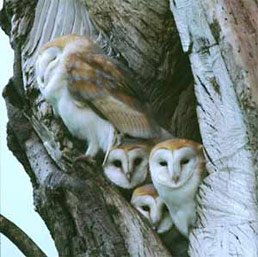Description
Barn owls live in many parts of the world. Their upper body is covered in grey feathers, dark, ribbon lines and pale spots. An owl’s lower body  consists of white with several black marks, just like a Dalmatian! Their faces are heart-shaped and white with brown edges. The eyes of a barn owl are surrounded with black marks. Fun fact, females have more pale spots than males and males have slightly longer legs than females.
consists of white with several black marks, just like a Dalmatian! Their faces are heart-shaped and white with brown edges. The eyes of a barn owl are surrounded with black marks. Fun fact, females have more pale spots than males and males have slightly longer legs than females.
Size
Males and females are almost the same in size. Females have a length of 34-40 cm with a wingspan of 110cm and a weight of 570 grams. A male has a length of 32-38 cm, a wingspan of 107 cm and a weight of 470 grams. Imagine holding 100 nickels, this is how much the average barn owl weighs!
Habit
These species are generally nocturnal. Specifically, they are most commonly seen active during daylight. When in flight, they are noiseless and unheard with an exception of wingbeats. They might not have the advantage to camouflage like other species; however, being silent is most definitely significant when catching prey
Voice
These barn owls are not like every other owl that hoots and whistles, these have a screeching voice. When these species return to their base, or home, they give a frog-like croak. When surprised by prey, they hiss and bill snap (snapping noises). By clicking their tongue, they make twitter sounds
Hunting & Food
Barn owls prey. on a variety of animals. They mainly prey on small ground mammals. For example, small rodents, voles, pocket gophers, shrews, mice and rats. Their secondary prey includes baby rabbits, bats, frogs, lizards, birds and insects. Most of their prey hide out in open grasslands
Breeding
Barn owls breed at random times during the year, depending on supply of food. The majority of barn owls nest (give birth) in old buildings,  caves, well shafts and tree hollows that are up to 20 metres in height. 3 to 6 eggs are laid at an interval of 2 days. Young birds are able to breed at about 10 months.
caves, well shafts and tree hollows that are up to 20 metres in height. 3 to 6 eggs are laid at an interval of 2 days. Young birds are able to breed at about 10 months.
Mortality
Barn owls are short-lived. Their life expectancy in the wild is between one and two years.
Habitat
Barn owls are mostly found in open grasslands. Sometimes, they are found in forested country. In the daytime, they are mainly found in tree hollows and sometimes caves, wells, out-buildings and thick foliage. Grasslands have deep soils and rich nutrients because there are many plant tissues in grasslands. Specifically, when plant tissues die off and decompose, they turn into nutrients. There are big amounts of clay, obtained from grassland soil. Big amounts of clay is an advantage for barn owls because plants will grow faster and barn owls eat plants. Initially, the clay keeps possession of the moisture, making plants grow faster in the spring, when there is lots of rain. Moisture is very important in a barn owl’s ecosystem because grasslands have very little rainfall; therefore, grasslands depend on evaporation (moisture) more than precipitation (rainfall).
